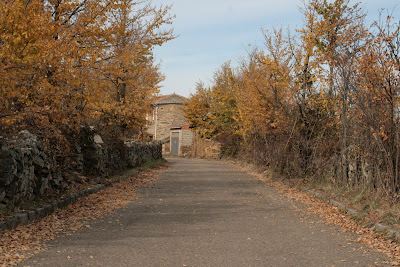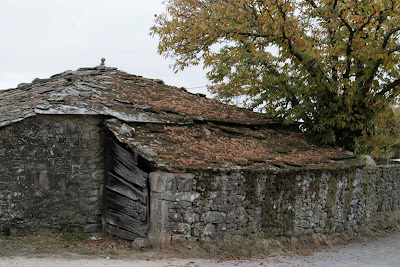The final section of the Camino Frances leaves the long flat plains of the meseta for the forested hills and valleys of Galicia. It is a remarkable change in more ways than one, but it begins in the Montes de Leon in the junta of Castilla y Leon. After leaving Leon the Camino, as if to torment those sick of the meseta and those who abandoned it, follows the highway for 30km (literally - the path is 200m or so to the south of it... truck drivers honk their horns and wave at you as they speed by). But very quickly the land changes and the hills, which for days have been dark silhouettes on the horizon, become solid. As the path moves higher and higher the very character of the experience changes.
When I first entered Spain I had asked some Spanish pilgrims about the issues of Independence that rage there. Their answer was that for the most part it was simple - they were all Spanish. But when it came to Galicia it was unanimous that the region was somehow different. There was Spain and there was Galicia. I found that difficult to picture, despite seeing the clear difference between the Basque and the French and Spanish, but kept it in the back of my mind nonetheless. On foot the Camino, but also Spain, changes radically with the ascent of the Montes de Leon. For me this lingers in three ways - landscape, weather, and food.
I've mentioned the hills. The first of them are gentle, dry, covered at this time of year (early November) with beautiful autumn golds and browns, and quite cold. These, the Montes de Leon are also filled with mysterious little stone-built villages. As I walked through one, with my walking partner Claudio from Sardinia, I got the feeling I was in a dream, or a lost land, reminding me of some scenes from Swift's Gulliver's Travels.

The buildings were small, often looking like they had suffered decades of neglect, yet there was a magic in the air. So it somehow seemed fitting that as Claudio and I stood in the middle of one lamenting the seasonal closure of the two bars (yes two! I think the owners accounted for over half the population), a small woman, clad in rustic black cloth (wool?) approached and asked if she could help. After establishing that the bars were indeed closed she wished us well and set off (though not before Claudio, ever the dashing gentleman, had whipped from his pack a bunch of flowers for her [still have no idea where he got them... I had been walking behind him for two hours and did not see them tucked anywhere]).
Three days later, when the Galician border is finally reached the hills have another character again - this time they are steep, green, and bitterly cold. But again, the little villages through which one walks have a dream like quality. Coming down from the highest of the Camino's mountains, O Cebreiro, I remember walking slowly and with a grin, or simply slack mouthed at the simple rustic charm of the particular hamlet I was passing through - cats lazed in sunny doorways, chooks grazed on the verge, chestnut trees attacked passersby with their spine covered nuts, grey coloured buildings of slate emitted warm glowing light and rich, hearty aromas. Just to make it all the more absurd, as Claudio and I walked through one little cluster of farmhouses an old woman scrambled out of her kitchen, calling us back to her. She had a plate stacked high with pancakes made with unpasteurised milk from her cows and eggs from her chickens. She grinned toothlessly at us as we moaned our delight (lemon and sugar pancakes - yum!) and explained she liked to do this for passing pilgrim. Claudio produced another bunch of flowers from nowhere for her in payment (perhaps it's some sort of Sardinian/Italian genetic ability to do magic).
But the hills are green for a reason. Galicia is renowned for its rain, and as the Camino flowed further eastwards the skies changed from clear blue to boiling grey and wet. Being November in the Northern Hemisphere this also meant another turn of blisteringly cold days, from which the only respite were smokey bars and fire lit restaurants. Like my time early on the meseta the cold turned the walking into a race from bar to bar. And in these bars, hiding from the icy rain I discovered what is possibly the greatest peasant's food of all time (I'm willing to be challenged on this though so long as the challenge includes flying me to wherever the food is ;-).

In the little stone-built bars of Galicia I encountered Caldo Gallego, and my what a life changing experience it was. I knew it was coming, of course, but all I knew was its name and that it contained cabbage. I didn't even know it was a soup. I've tasted some of the other great dishes of the rural world - Boeuf Bourguignon, Lancashire Hotpot, and the classic Irish Stew - but this blows them all away. Imagine cold, wet winter's days with grey skies above and glistening emerald green countryside all around. You scurry into a squat grey stone building with moss covered slate roofing. Inside there's a warm fire, it's smokey (from cigarettes, cigars, and wood on the fire) and homey, and the welcome is warm and strong. You ask for some food. There is only one thing on the menu and it is ladled into a bowl and presented to you steaming, accompanied by thick artisinal bread. When you take your first mouthful you relax - it warms your insides, your heart, and somehow your soul. When you eat Caldo Gallego you eat the earth from which it was made. It sounds fanciful but there's something deeply satisfying about this dish; the hot earthy spiciness of the chorizo, the rejuvenating stodge of the potato and white beans, or the burst of vitamins and minerals from the cabbage and kale. When you finish you couldn't possibly eat another thing, but you know you have eaten healthily, and you now have the energy and courage to face the bleak but beautiful weather outside again. That's Caldo Gallego, and indeed Galicia, as I remember it.
More: Full post
